Crochet is a relaxing craft that people of all ages can enjoy. In order to have the most successful experience, it's important to have the right crochet supplies when you begin.
In this post, we cover the basic tools you need to get started with crochet, including the best types of hooks and what yarn to use as a beginner (plus what yarn to definitely avoid!).
I'll give you my honest opinion on which supplies are must-haves and which are just fun-to-have. By the end of this guide, you'll be ready to run to the craft store with a list of the essential crochet supplies for beginners.
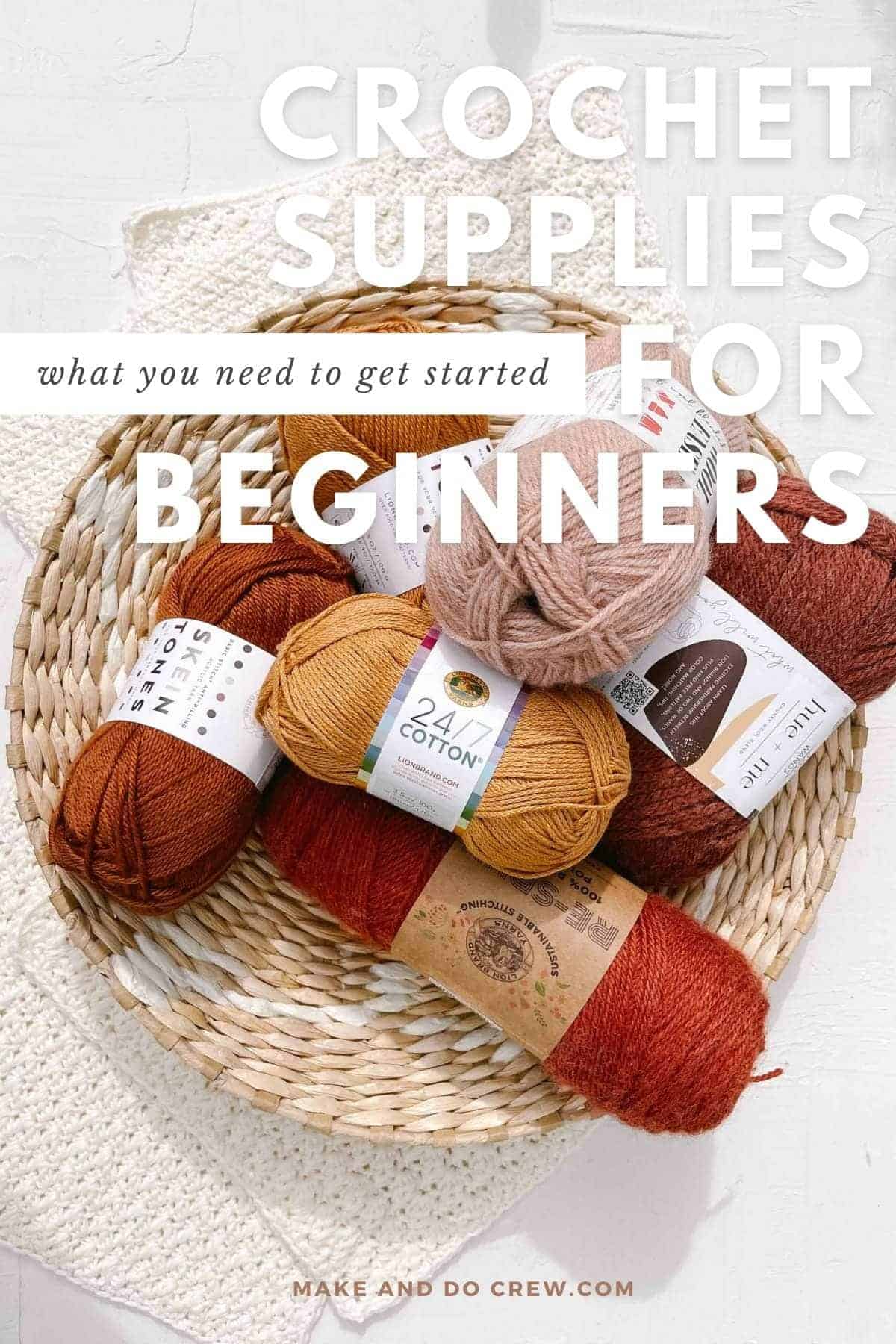
This guide on supplies for crocheting contains affiliate links.
Quick Start: Crochet Supplies for Beginners
If you’re eager to learn how to crochet, I won’t drag this out. You can get started practicing the basic stitches with these simple supplies:
• Crochet hook
• Yarn
• Scissors
Before you click “add to cart” though, spend a few minutes reading exactly which type of tools to choose so you can avoid frustration from the get-go.
Jump to:
- Quick Start: Crochet Supplies for Beginners
- What Materials Do You Need to Start Crocheting?
- Crochet Hooks
- Yarn For Beginners
- Tapestry Needle
- Stitch Markers
- Scissors
- Measuring Tape
- Other Crochet Tools and Materials
- Tips for Beginners
- Explore Crochet Projects for Beginners:
- FAQs
- Invitation to our Facebook group
What Materials Do You Need to Start Crocheting?
In this guide, we talk more about each of these essential supplies, plus some additional “nice-to-haves” that you can add to your crocheting wish list.
All of these crochet materials can be found online or at your local craft store. You can go shopping today and be crocheting a new project by tonight!
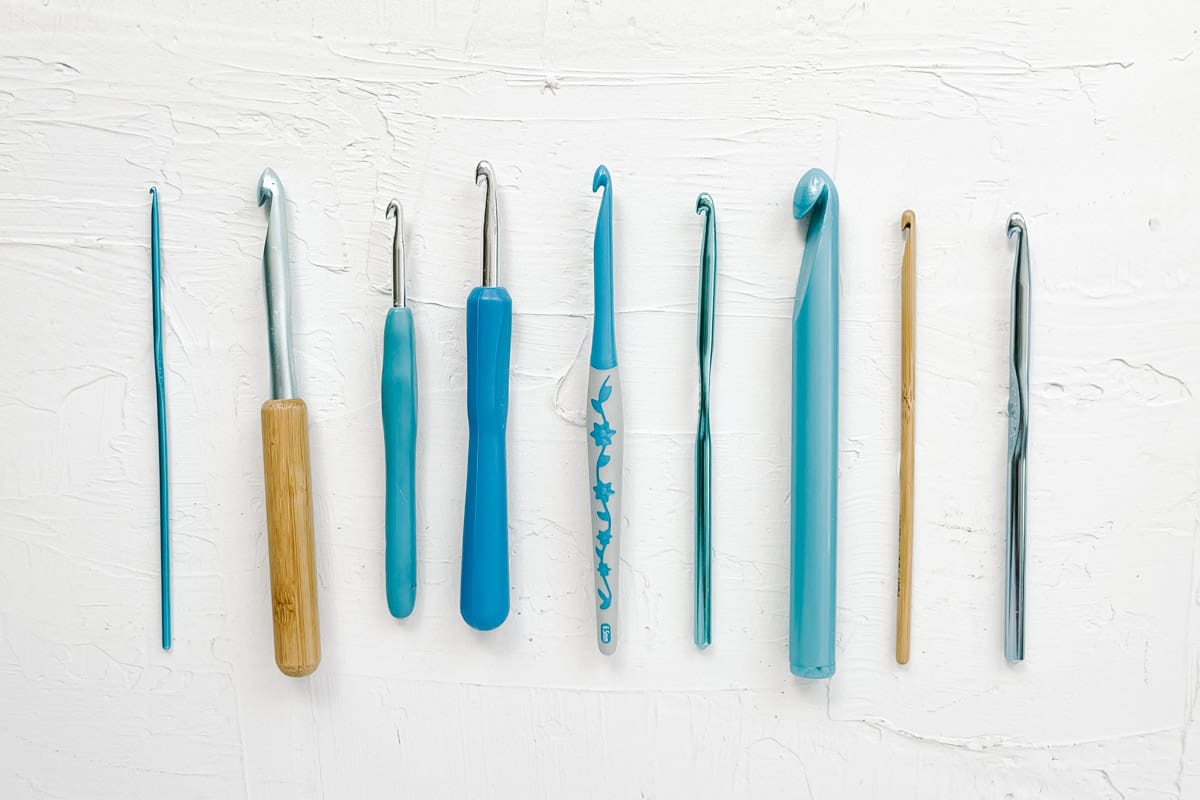
Pin it! click to save this guide for later ⇨
Crochet Hooks
If you’re familiar with knitting, you know that it uses two needles to combine stitches into a beautiful fabric. Crochet, on the other hand, uses only a single hook to create looped stitches.
What’s the Best Crochet Hook for a Beginner?
Crochet hooks come in different types, materials, and sizes to match different yarn weights. I recommend starting out with a hook size between I (5.5mm) and L (8.00mm) for a beginner.
Let’s take a look at what to consider specifically when choosing a crochet hook.
Material
Crochet hooks can be made from plastic, bamboo, aluminum, glass, and even hand-carved wood. Each material has its own qualities that make it good for crocheting. Ultimately, I suggest trying a few different types and deciding which feels best to you.
- Aluminum Hooks: This is the most common hook type you’ll find in stores, often made by Boye or Susan Bates. They're lightweight and inexpensive, although their thin handles can cause hand strain when crocheting several hours a day (which I promise you can be doing in no time!)
- Wooden/Bamboo Hooks: These are lightweight and warm in hand, making them a good choice if you have arthritis or other hand pain. They also provide a little more friction against the yarn, which can be helpful for beginners that are just getting the hang of keeping consistent yarn tension.
- Plastic Hooks: Also lightweight and inexpensive, plastic is often used for larger hook sizes where metal or wood might be too heavy. (Although some of my favorite ergonomic crochet hooks are also made of plastic.)
- Steel Hooks: These are typically used with very fine yarn, such as when crocheting doilies or other lacework. As a beginner, I don’t suggest you start with these tiny hooks.
- Ergonomic Hooks: Hooks with this feature typically have a thicker handle to reduce strain on the hand during long crochet sessions. Once you fall in love with the craft, I highly recommend finding ergonomic hooks that you enjoy using. (You can find great options at every price point.)
- Tunisian/Afghan Hooks: These are longer than standard crochet hooks and sometimes have a hook at both ends. They're used for a specific type of crochet where many loops of yarn stay on the hook at once. You don’t need to worry about these unless you’re learning how to Tunisian crochet.
- Double-Ended Crochet Hooks: These have a hook on each end of the tool and are often used for a technique called "cro-hooking" or "double-ended" crochet. Again, these aren’t relevant when you’re learning the basics of crochet.
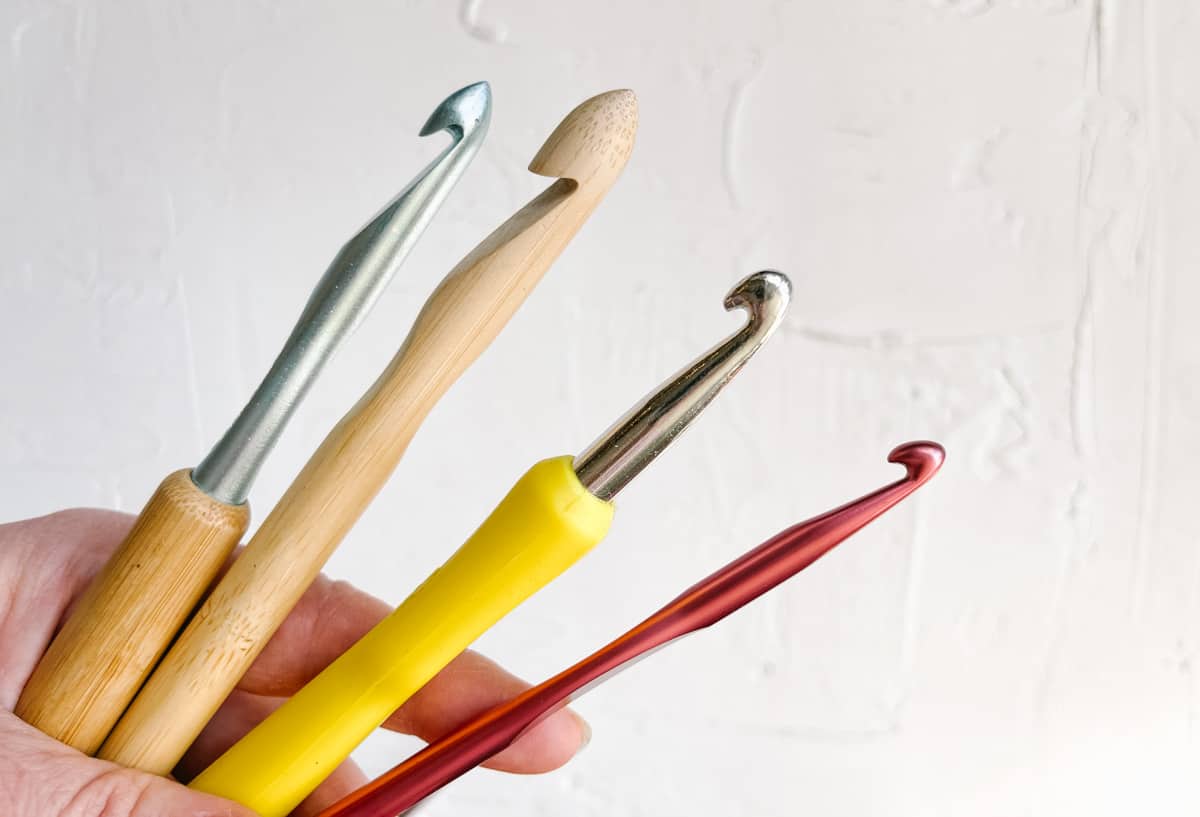
Shape
When we talk about the shape of a crochet hook, we’re referencing the actual hook section at the end of the shaft. As a beginner, it’s not important to memorize the shapes and names, but rather to begin to pay attention to what you prefer using.
Here are the shapes of crochet hooks you’ll come across.
Inline Hooks:
Inline hooks have a hook shape that’s the same width as the shaft. They have a relatively deep mouth for grabbing the yarn. You might find this shape crochet hook easier when working into tight stitches, such as making amigurumi stuffed animals or crocheting sun hats.
Tapered Hooks:
Tapered crochet hooks have a more rounded head and a shallower mouth compared to inline hooks. This can help you crochet blankets and sweaters at a quicker pace and reduce the chances of splitting the yarn.
Crochet Hook Size
The size of a crochet hook is determined by the circumference around the hook. The size you use will be guided by the type of yarn and pattern you’re using. Almost always, your pattern will tell you what hook size is needed. You can also find the recommended hook size for skein of yarn on the product label.
How to Choose the Right Hook Size for Your Yarn?
Pairing the right size hook with your yarn is really important, but it’s also quite easy to figure out. If your hook is too small, the stitches will be tight. If it's too big, the stitches will be loose and net-like.
To pick the right hook size, look at the yarn label for the recommended size. Thin or lightweight yarns such as DK weight generally use smaller-sized crochet hooks. The pattern will call for a larger hook if you’re working with chunky, bulky, or jumbo yarn.
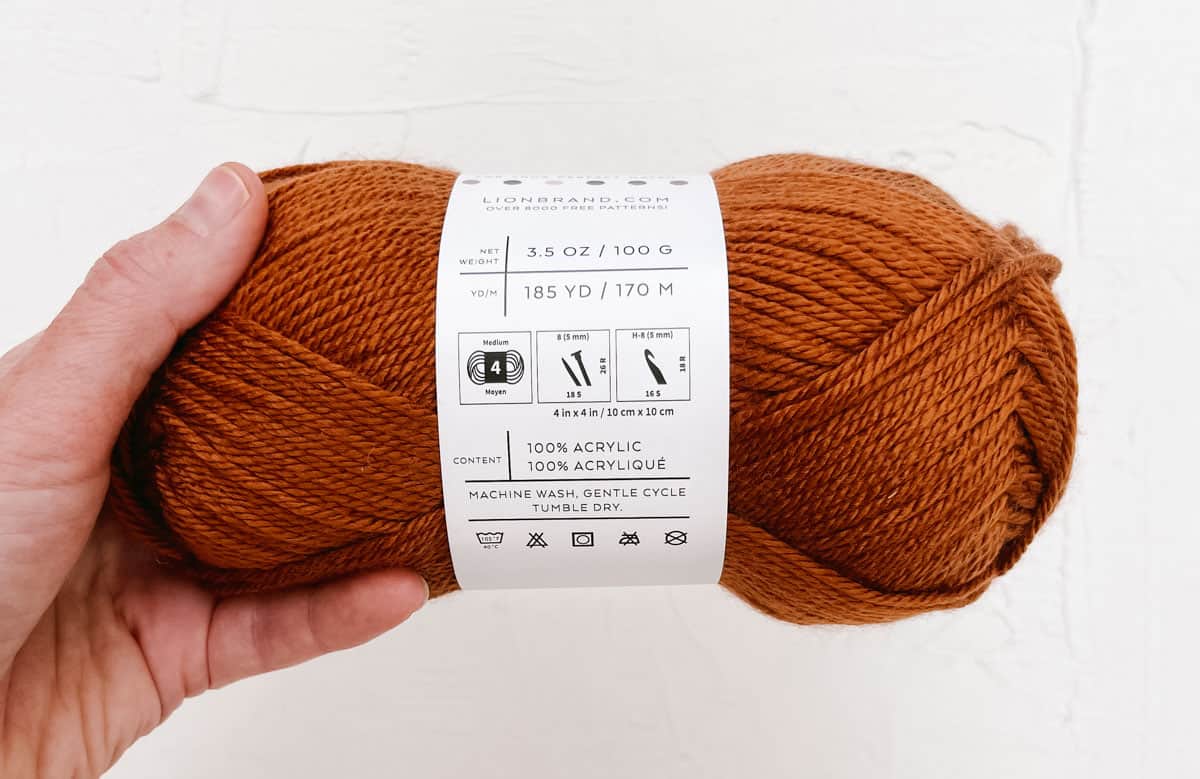
Yarn For Beginners
Yarn shopping can be just as exciting as finishing a crochet project. (In fact, some people admit to being more into the hobby of collecting beautiful yarn than actually crocheting!) It can also be overwhelming because there are so many different fibers, textures, and colors.
Here are some things to keep in mind when choosing yarn for your crochet project.

Yarn Weight
Yarn weight simply means how thick or thin the yarn is based on the Craft Yarn Council’s standardized system. Yarn weight categories include:
- Lace (#0)
- Superfine (#1)
- Fine (#2)
- DK/light (#3)
- Medium (#4 – also called worsted weight)
- Bulky (#5)
- Super bulky (#6)
- Jumbo (#7)

How can you tell what weight category a yarn falls into? Check the label for a number between 1-7, usually inside the icon of a skein of yarn. If you’re following a pattern, it will often specify what yarn weight to use.
Fiber Content
Yarn comes in a variety of synthetic fibers and natural fibers, like silk, wool, acrylic, and cotton. Each type has different characteristics, so think about what you’re making and how it will be used.
For example, if you’re crocheting a baby blanket, you’ll probably want a super soft, machine-washable yarn. When you're learning how to crochet a sweater, the perfect yarn will be comfortable, drape well, and be available in many wearable color choices.
| Fiber Type | Why Crocheters Like It | Beginner Suggestion |
|---|---|---|
| Acrylic Yarn | Affordable, easy to work with, comes in various colors, durable, can be machine-washed and dried, but can be prone to pilling and doesn't have the same natural feel as other fibers. | Basic Stitch Anti-Pilling Hue + Me |
| Wool and Wool Blends | Cool and breathable, with a matte sheen. It doesn't have the same elasticity as wool or acrylic, making it stiffer for garments. | Wool-Ease Wool-Ease Thick & Quick |
| Cotton Yarn | Cool and breathable, with a matte shein. It doesn't have the same elasticity as wool or acrylic, making it stiffer for garments. | 24/7 Cotton Pima Cotton |
Color
One of the most exciting things about choosing yarn is deciding what colors to use. If you’re like me, you’ve never seen a warm, neutral color you don’t love. Or maybe you prefer the bright, bold colors of Mandala yarn.
Whether you choose a monochromatic theme or go with self-striping yarn, you’ll want to pick colors that you (or the recipient of your gift) will enjoy for a long time.
Texture
The texture of yarn can add depth and interest to your project. When you’re choosing beginner crochet supplies, though, it’s important to stay away from super textured and fuzzy yarns.
Why? Boucle, nubby, and novelty yarns tend to be harder to see your stitches, so it’s best to save them for once you’ve had a bit more experience. When you're ready, try these patterns that call for fuzzy yarns:
Yarns to Avoid as a Beginner
As I mentioned above, a few types of yarns aren’t ideal for practicing basic crochet skills. Here’s what not to buy as a beginner!
Highly Textured Yarns:
It's tough to see your stitches with textured yarn, so use a smooth yarn with even thickness.
Dark Colored Yarn:
Dark yarn also makes it hard to see your stitches. Choose a neutral or pastel color yarn that's easy on the eyes.
Pro Tip: When you're ready to try working with darker yarn, having a hobby light can be really helpful. This is the one I gave my mom for Christmas.
Yarn That’s Too Thick or Too Thin:
Very thick yarn can be tough to handle, and thin yarn takes forever to see progress. As a beginner, look for a category 4 worsted-weight yarn or category 5 bulky-weight yarn.
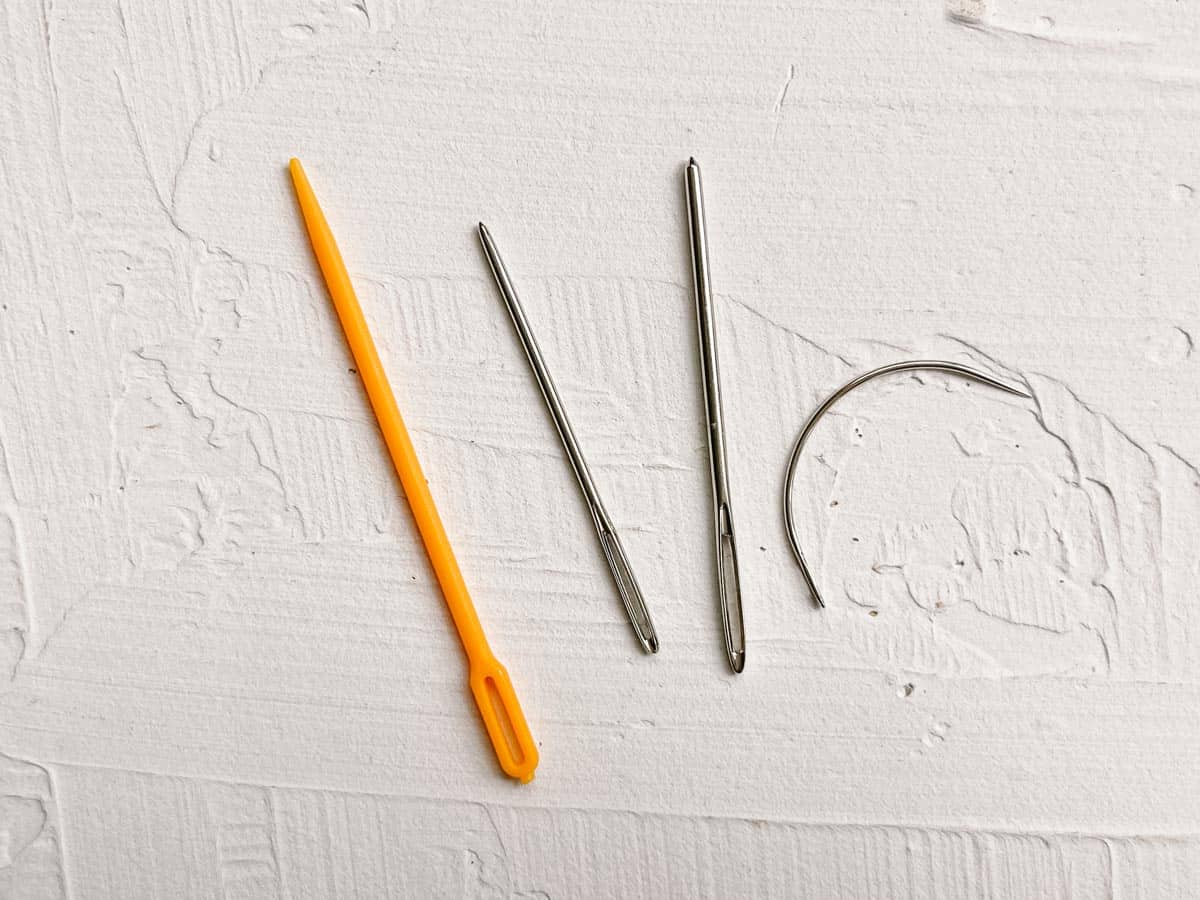
Wanna save this pattern?
Tapestry Needle
Tapestry needles (also called yarn needles or darning needles) are blunt-tipped needles used for weaving in ends and sewing pieces together.
While many patterns can be made seamlessly, you’ll always want to weave in your yarn tails to give your project a finished, professional pizazz. (Seriously, don’t skip this step!)
Size
Just like crochet hooks, tapestry needles come in many different sizes. Most importantly, choose a size that allows the yarn you’re working with to fit through the eye of the needle.
Shape
You’ll probably come across straight yarn needles and ones with a bent tip. Straight needles are helpful for sewing together large pieces of crochet fabric.
Bent-tip needles are my favorite because they work well for many use cases, including seaming in tight spaces, like when attaching limbs to amigurumi dolls.
Material
Yarn needles are made of metal or plastic. I find metal needles to work the best in most cases, but I like to keep a few packs of inexpensive plastic needles around as backups. (And they’re awesome for kids to practice sewing with!)
Ultimately, the best tapestry needle shape and material are largely based on personal preference, so try a few to see what you like.
Stitch Markers
Stitch markers are small, circular clips or rings that help mark your place in a crochet project. They’re available in different colors and sizes and are particularly useful for tracking where you started crocheting in the round.
Pro Tip: Make it a habit to put a stitch marker in the “live” loop of your work-in-progress crochet project when you’re done working. This prevents the stitches from unraveling until your next crochet session.
Scissors
A good pair of scissors is necessary for cutting yarn and trimming ends. I recommend keeping a little pair of folding scissors in your project bag because they tend to be small enough to bring on airplanes. (Anything with a blade under 4” is currently allowed to bring on board.)
Measuring Tape
A flexible measuring tape is essential to measure your gauge and keep track of your project's size. I like using a soft, retractable tape measure because its small, compact size makes it easy to stash in my bag.
Other Crochet Tools and Materials
While you only need the must-have crochet supplies to get started, I’ve included some fun extras to put on your wishlist as you fall in love with this hobby.
Crochet Hook Organizer
A crochet hook organizer can help you keep your hooks straight by size or by project. It can also help protect them from getting damaged or lost (my biggest issue!) and keep them from getting tangled up with other tools.
When choosing an organizer, think about how many hooks you have and what type of storage would work best for you.
Blocking Mat
A blocking mat provides a flat surface for blocking and shaping your work. The grid on the mat helps you measure and adjust your project's size and shape, ensuring it matches the pattern. You can also make your own DIY blocking board.
Full Disclosure: I didn’t own a blocking board for my first 30 years of crocheting, so it’s definitely not a must-have. Now that I have one, though, I can’t imagine living without it!
T-Pins
T-pins are typically made of metal and have a flat, broad head on one end with a sharp point on the other. They are used to hold crocheted or knitted items in place on a blocking mat, allowing them to be shaped and sized as desired.
It’s important to choose T-pins made of rust-free materials, such as stainless steel or nickel-plated steel, to ensure they don’t corrode or damage your project.
Pro Tip: Blocking combs are an alternative that combines many pins in one easy-to-manage strip. I recently discovered this helpful little tool, and I’m in love!
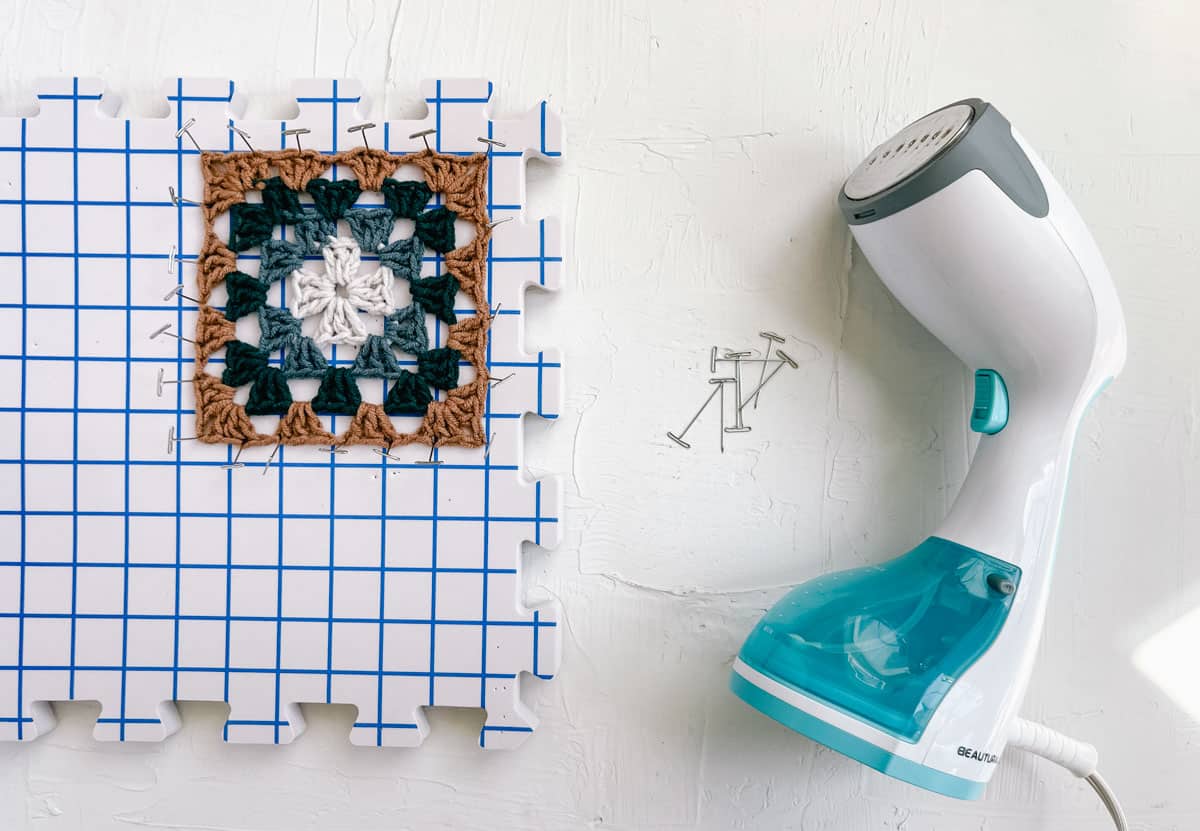
Steamer
A steamer or iron with a steam function is a helpful tool for blocking and finishing your crochet work. During the blocking process, hot steam relaxes the fibers of your crochet item to make your stitches look flat, even, and consistent.
Swatch Ruler
A swatch ruler helps you measure the gauge of your swatch, so you can adjust your hook size to match the pattern’s intended size and shape. I really like to use swatch rulers that are made of clear plastic.
You can use a regular ruler or measuring tape as an alternative.
Yarn Bowl
A yarn bowl can keep your yarn clean, tangle-free, and easily accessible while you work. It also prevents the yarn from rolling away, getting snarled on other objects, or becoming your pet’s latest obsession.
You can also use inexpensive household items like a laundry basket or paper towel holder to keep yarn organized.
Row Counter
As it sounds, a row counter can help you track the rows you've crocheted. I find this especially helpful when my project requires a specific number of rows, but I’m also distracted by my kids (or let’s be honest, my favorite Netflix show.)
Ball Winder and Yarn Swift
A ball winder and yarn swift are two tools that are often used together to wind hanks of yarn into neat and organized balls. While they are not crochet must-haves, they can be a worthwhile investment if you buy a lot of hand-dyed yarn that is often wound loosely in a hank.
Crochet Bag
Who doesn’t want an excuse to buy a new bag? A crochet tote bag is useful for stashing all your tools and materials.
When shopping for a project bag, look for one that has pockets for your crochet supplies and, ideally, a way to easily feed your yarn out when you want to craft on the go.
Crochet Books + Stitch Dictionaries
While everything you need to know as a beginner crocheter can be found on the internet, I wholeheartedly recommend browsing through a few books as well.
Whether you’re just learning the basics or looking to expand your skills, a good crochet book can provide you with inspiration, guidance, and helpful tips and techniques.
And when you’re ready to learn how to corner-to-corner crochet, check out my book that covers everything you need to know!
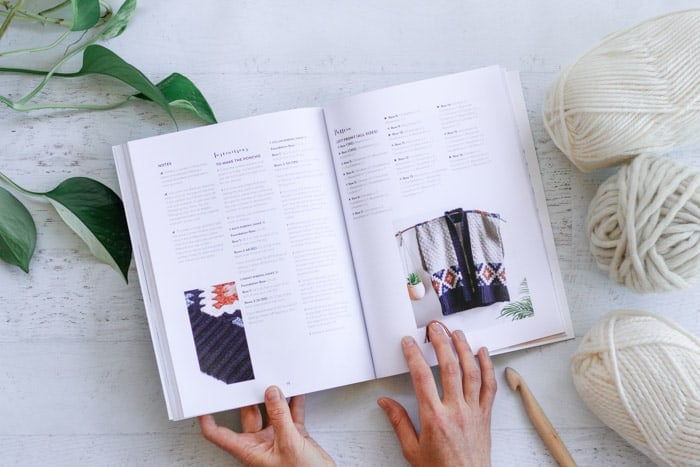
Tips for Beginners
Crochet is a fun and rewarding hobby, but like anything new, it can be overwhelming to know how to get started. Here are some tips to help make your crochet journey a success:
Begin with Basic Supplies
As we covered here, you only need a few crochet tools to get started. Grab a thick-ish yarn in a color you love and pair it with the hook size recommended on the yarn label. These are the only supplies you absolutely need to begin practicing.
Start with Simple Projects
When you first learn to crochet, start with simple projects. Crochet patterns made from rectangles are often beginner-friendly. Our ribbed winter beanie is an ideal first project.
Once you have a few beginner projects under your belt, try making a scarf, a dish towel, or even a chunky cardigan.
Watch Crochet Tutorials with Videos:
This is one time that it's okay to spend all day on YouTube! You’ll find tons of step-by-step video tutorials to practice basic techniques.
Have Fun!
As adults, we can often go months or years without having to struggle through learning a new skill. Go easy on yourself as you build the muscle memory of how to hold the yarn and hook. I promise that learning how to crochet will be completely worth it!
Explore Crochet Projects for Beginners:
Look for crochet projects that are made for designed for beginners, like beanies, coasters, headbands, and simple stuffed toys. These projects are good for improving your skills and making something pretty.
Here are a few easy patterns to get you started:
FAQs
The best type of crochet hook for beginners is an ergonomic hook with a comfortable grip. Ergonomic hooks have a larger handle that is easier to grip, reducing hand fatigue and strain. Additionally, hooks with tapered throats make pulling the yarn through the loops easier.
The best size crochet hook for beginners will depend on the weight of the yarn being used. Generally, a size H-8 (5mm) hook is a good starting point for worsted weight yarn, while a size L (8mm) hook is a good choice for bulkier weight yarns.
The number of hooks you need depends on your project and personal preferences. As a beginner, starting with a few hooks in different sizes, such as 5.00 mm, 6.00 mm, and 10.00 mm is a good idea.
Over time, you may want to add to your collection as you try new yarn weights and projects. However, it's possible to complete many projects with just a few hooks.
A crochet kit typically includes a pattern and all the materials needed to complete a specific project, such as yarn, a crochet hook, and sometimes, any necessary notions like stitch markers or tapestry needles.
We have lots of crochet kits that include the ad-free, printable PDF pattern, plus all the yarn needed for your project. They’re shipped straight to your door, so you can skip the trip to the craft store and get right to crocheting.
The right crochet hook size depends on the weight of the yarn you're using and the pattern you're following. It's important to check the yarn label or pattern instructions for the recommended hook size and to test your gauge before starting your project.
Acrylic yarn is synthetic and easy to care for, while wool yarn is a natural fiber and provides warmth and water resistance. Acrylic yarn is typically less expensive than wool yarn and comes in a wider range of colors.
Stitch markers are used to mark the beginning of a round or a specific place in a WIP (work-in-progress project). They can also be used to mark the end of a row or to keep track of pattern repeats.
A ball winder is a mechanical tool used to wind yarn into a center-pull ball, while a yarn swift is a wooden or metal frame used to hold a skein of yarn and rotate it while you wind the yarn into a ball.
A tapestry needle has a larger eye and a blunt tip, which makes it ideal for weaving in yarn ends and sewing pieces together in crochet projects. On the other hand, a regular needle has a smaller eye and a pointed tip, which is better for sewing fabrics together with thread.
That was so fun! Now what?
Invitation to our Facebook group
Come discuss your favorite crochet supplies and lots of other yarn-y topics and techniques in our Make & Do Crew Facebook group. Here thousands of helpful crocheters answer each other's questions and share their stitches. Come join us here.

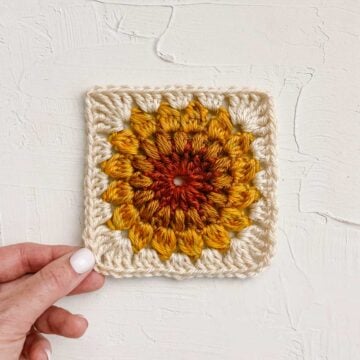
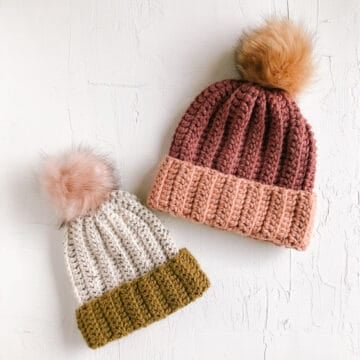
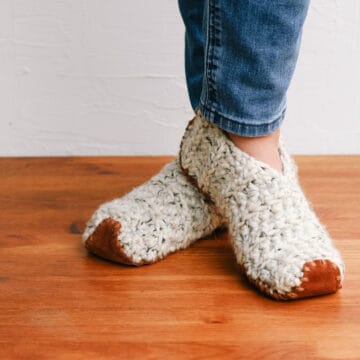
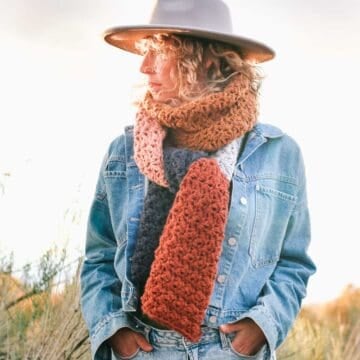
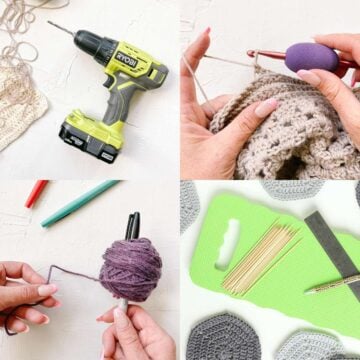
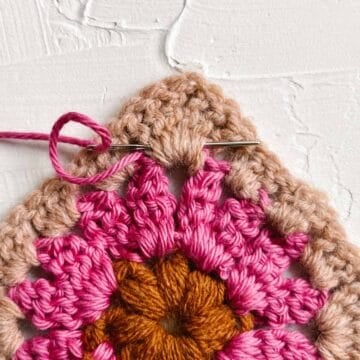
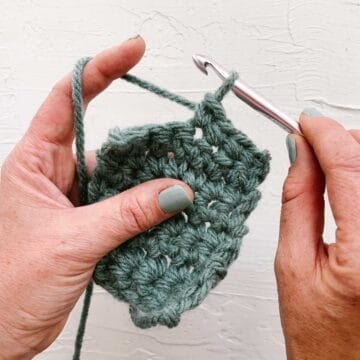
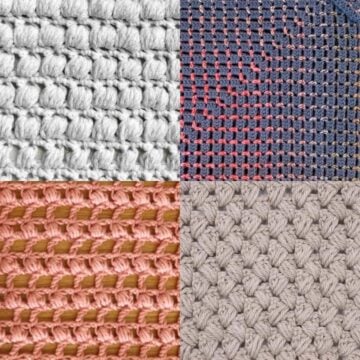
Leave a Reply